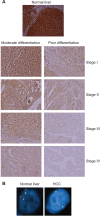Emerging role of insulin-like growth factor-binding protein 7 in hepatocellular carcinoma
- PMID: 27508172
- PMCID: PMC4918263
- DOI: 10.2147/JHC.S44460
Emerging role of insulin-like growth factor-binding protein 7 in hepatocellular carcinoma
Abstract
Hepatocellular carcinoma (HCC) is a vicious and highly vascular cancer with a dismal prognosis. It is a life-threatening illness worldwide that ranks fifth in terms of cancer prevalence and third in cancer deaths. Most patients are diagnosed at an advanced stage by which time conventional therapies are no longer effective. Targeted molecular therapies, such as the multikinase inhibitor sorafenib, provide a modest increase in survival for advanced HCC patients and display significant toxicity. Thus, there is an immense need to identify novel regulators of HCC that might be targeted effectively. The insulin-like growth factor (IGF) axis is commonly abnormal in HCC. Upon activation, the IGF axis controls metabolism, tissue homeostasis, and survival. Insulin-like growth factor-binding protein 7 (IGFBP7) is a secreted protein of a family of low-affinity IGF-binding proteins termed "IGFBP-related proteins" that have been identified as a potential tumor suppressor in HCC. IGFBP7 has been implicated in regulating cellular proliferation, senescence, and angiogenesis. In this review, we provide a comprehensive discussion of the role of IGFBP7 in HCC and the potential use of IGFBP7 as a novel biomarker for drug resistance and as an effective therapeutic strategy.
Keywords: HCC; IGFBP7; angiogenesis; apoptosis; gene therapy; senescence.
Figures


Similar articles
-
IGFBP7 Deletion Promotes Hepatocellular Carcinoma.Cancer Res. 2017 Aug 1;77(15):4014-4025. doi: 10.1158/0008-5472.CAN-16-2885. Epub 2017 Jun 15. Cancer Res. 2017. PMID: 28619711 Free PMC article.
-
IGFBP7 downregulation is associated with tumor progression and clinical outcome in hepatocellular carcinoma.Int J Cancer. 2012 Jan 15;130(2):319-27. doi: 10.1002/ijc.25994. Epub 2011 Apr 13. Int J Cancer. 2012. PMID: 21328580
-
Circulating cell-free DNA of methylated insulin-like growth factor-binding protein 7 predicts a poor prognosis in hepatitis B virus-associated hepatocellular carcinoma after hepatectomy.Free Radic Res. 2018 Apr;52(4):455-464. doi: 10.1080/10715762.2018.1443448. Epub 2018 Mar 15. Free Radic Res. 2018. PMID: 29463155
-
Targeting the insulin-like growth factor pathway in hepatocellular carcinoma.World J Hepatol. 2014 Oct 27;6(10):716-37. doi: 10.4254/wjh.v6.i10.716. World J Hepatol. 2014. PMID: 25349643 Free PMC article. Review.
-
Insulin Growth Factor Binding Protein 7 (IGFBP7)-Related Cancer and IGFBP3 and IGFBP7 Crosstalk.Front Oncol. 2020 May 15;10:727. doi: 10.3389/fonc.2020.00727. eCollection 2020. Front Oncol. 2020. PMID: 32500027 Free PMC article. Review.
Cited by
-
[Effects of maternal folate deficiency on the methylation of insulin-like growth factor system in the offspring rats].Zhongguo Dang Dai Er Ke Za Zhi. 2017 Apr;19(4):470-474. doi: 10.7499/j.issn.1008-8830.2017.04.021. Zhongguo Dang Dai Er Ke Za Zhi. 2017. PMID: 28407838 Free PMC article. Chinese.
-
Insulin-like growth factor-binding protein 7 (IGFBP7): A microenvironment-dependent regulator of angiogenesis and vascular remodeling.Front Cell Dev Biol. 2024 Jul 9;12:1421438. doi: 10.3389/fcell.2024.1421438. eCollection 2024. Front Cell Dev Biol. 2024. PMID: 39045455 Free PMC article. Review.
-
A bioinformatic study of IGFBPs in glioma regarding their diagnostic, prognostic, and therapeutic prediction value.Am J Transl Res. 2023 Mar 15;15(3):2140-2155. eCollection 2023. Am J Transl Res. 2023. PMID: 37056850 Free PMC article.
-
The Rise of IGFBP4 in People with Obstructive Sleep Apnea and Multilevel Sleep Surgery Recovers Its Basal Levels.Dis Markers. 2021 Oct 4;2021:1219593. doi: 10.1155/2021/1219593. eCollection 2021. Dis Markers. 2021. PMID: 34646401 Free PMC article.
-
Epithelial cell senescence: an adaptive response to pre-carcinogenic stresses?Cell Mol Life Sci. 2017 Dec;74(24):4471-4509. doi: 10.1007/s00018-017-2587-9. Epub 2017 Jul 13. Cell Mol Life Sci. 2017. PMID: 28707011 Free PMC article. Review.
References
-
- El-Serag HB, Rudolph KL. Hepatocellular carcinoma: epidemiology and molecular carcinogenesis. Gastroenterology. 2007;132(7):2557–2576. - PubMed
-
- Carr BI, Pujol L. Pain at presentation and survival in hepatocellular carcinoma. J Pain. 2010;11(10):988–993. - PubMed
-
- El-Serag HB. Hepatocellular carcinoma. N Engl J Med. 2011;365(12):1118–1127. - PubMed
-
- Naugler WE, Sakurai T, Kim S, et al. Gender disparity in liver cancer due to sex differences in MyD88-dependent IL-6 production. Science. 2007;317(5834):121–124. - PubMed
Publication types
Grants and funding
LinkOut - more resources
Full Text Sources
Other Literature Sources
Miscellaneous

